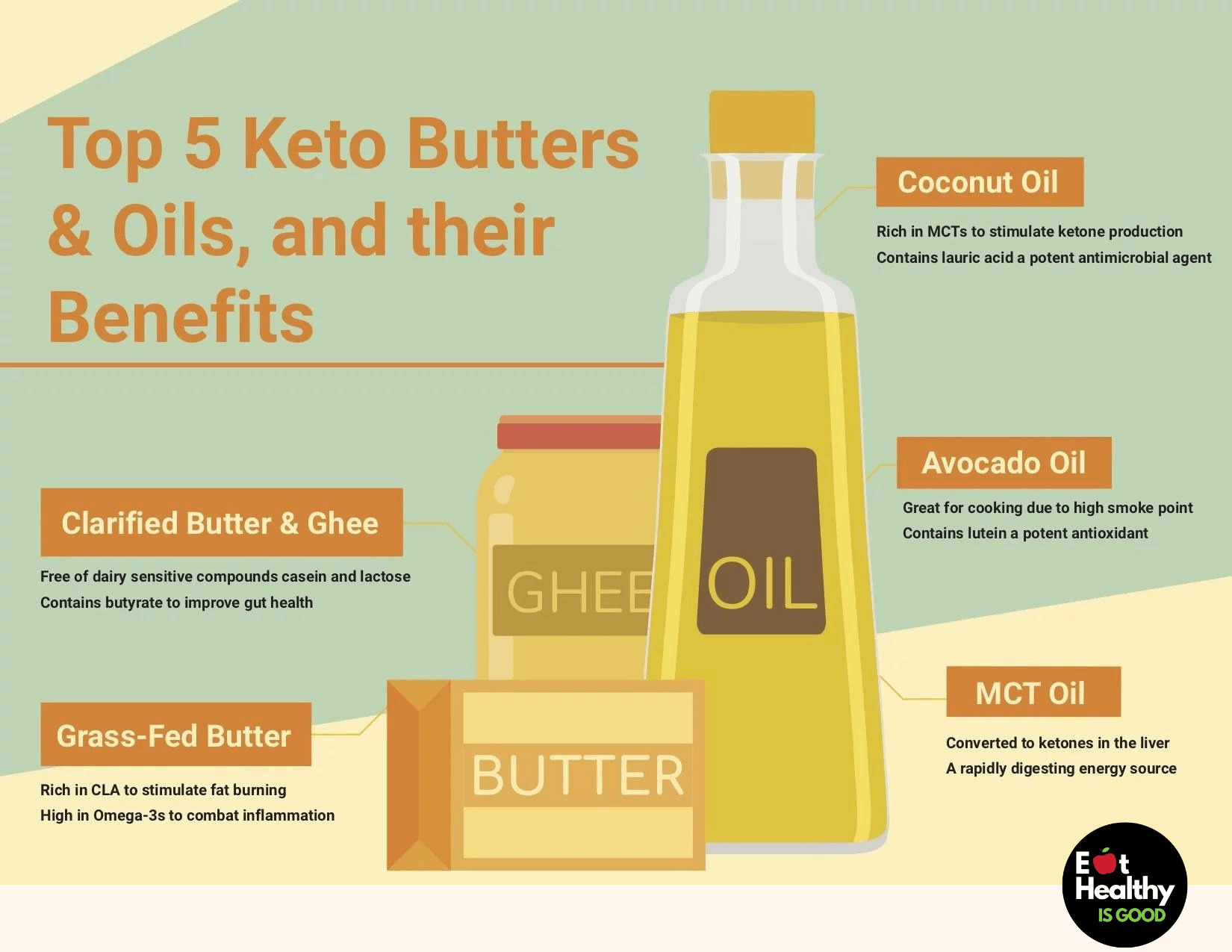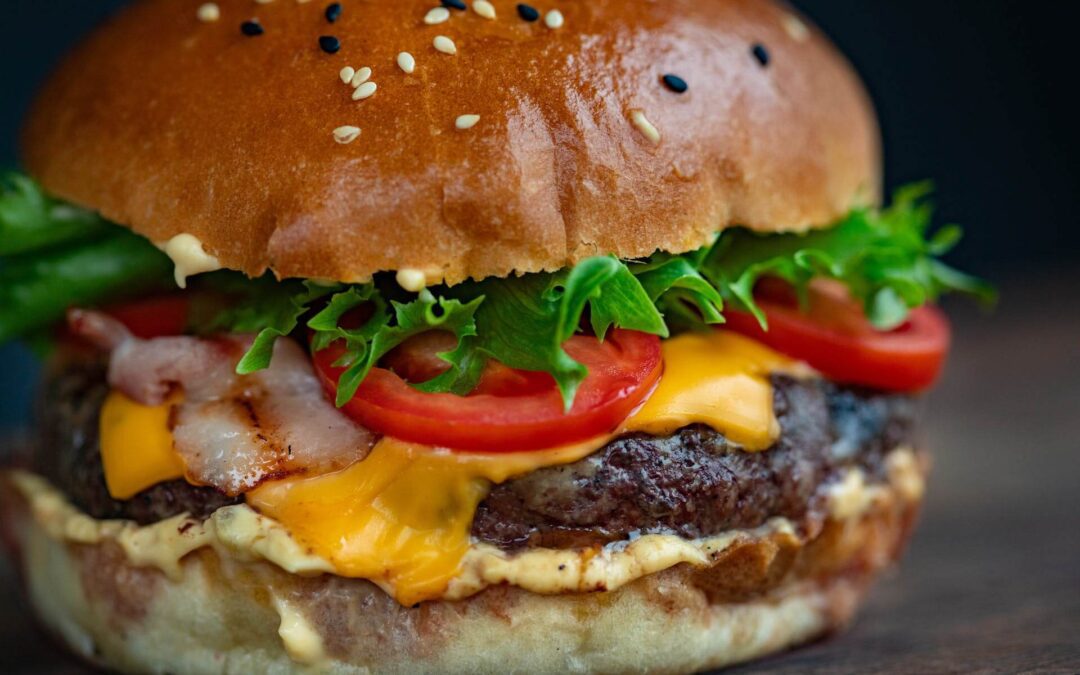Rejoice! Even if you want to lose weight, you may say, “Pass the butter!” or “Extra salad dressing, please!” now that you’re on a high-fat, low-carb diet.
Indeed, butter and oils, both of which are high in fat, play a vital role in keto cuisine and its health advantages. But not all oils are made equal; some oils are effective at keeping you in ketosis, making these healthy fats a regular diet component. Others you should avoid. Today, we’ll go through the fundamentals of these ingredients/condiments.
It’s simple to go from using all types of cooking fats to only keto-friendly ones. If you cook, you already have several excellent alternatives in your pantry. Look over the keto-friendly options below and use them anytime you need to cook, prepare a dressing, or finish a meal with a drizzle of oil or a smear of butter.

Butter
On the ketogenic diet, butter, especially grass-fed butter, gets a significant thumbs up since it contains just trace quantities of carbohydrates per serving, whether salted or unsalted. Butter, like other fatty dairy products, is high in conjugated linoleic acid (CLA), a fatty acid that may aid in fat reduction. Grass-fed butter has five times the CLA of grain-fed butter and is substantially richer in Omega-3 fatty acids and vitamin K2. Cook with it, bake with it, put it in your bulletproof coffee, or spread it liberally when you need additional fat macros. Radishes with butter and flaky salt, a traditional French snack? Delicious and completely keto!
Butter Nutritional Information: 1 Tbsp: 102 Calories, 0.1g Protein, 12g Fat, 0g Carbs.
Clarified Butter and Ghee
Clarified butter and ghee are simply butter without the milk solids; they’re virtually entirely made up of fat, the majority of which is saturated fat.
Clarified butter is created by heating butter, removing it from the heat after the butterfat and milk solids separate, and then skimming and discarding them. Ghee, “fat” in Hindi, is butter cooked a little longer to allow the milk solids to caramelize and provide a richer golden color and unique nutty flavor before being skimmed and removed. In both cases, what’s left is pure butterfat, which may be consumed and utilized in the same manner as butter. Because ghee separates milk from fat, it is lactose-free, making it superior to butter if you have dairy allergies or sensitivities.
Because clarified butter and ghee do not include quickly rotting liquid and milk components, they have longer shelf lives, so they are mainstays in hot climates. They also have significantly greater smoke points than butter, making them ideal for cooking.
Because store-bought ghee is pricey and scarce in grocery shops, many ketonians create their own. The recipe is simple. Check it out for yourself.
Clarified Butter and Ghee Nutritional Information: 1 Tbsp: 112 Calories, 0g Net Carbs, 13g Fat, 7.9g Protein.
Coconut Oil
Coconut oil has certain qualities that make it ideal for keto cooking. It’s high in medium-chain triglycerides (MCTs; roughly 50%), which can boost ketone generation, raise metabolic rate, and stimulate weight and belly fat loss. It’s solid at room temperature, like other mainly saturated fats (like butter), and may be used in place of any nut, seed, or vegetable oil; however, when replacing coconut oil for a solid fat, like butter or lard, use 25% less coconut oil than the recipe asks for. Do you want to try cooking with coconut oil?
Coconut Oil Nutritional Information: 1 Tbsp: 121 Calories, 13g Fat, 0g Net Carbs, 0g Protein
Avocado Oil
Avocado oil is just avocado oil that has been squeezed. It contains 70% oleic acid and is high in monounsaturated fats. Add to that its mild flavor and high smoke point (the point at which the oil begins to burn and its smell and taste change), and it’s easy to see why it’s a keto cooking mainstay. Use this versatile oil in salad dressings, marinades, sautes, and homemade mayonnaise recipes.
Avocado Oil Nutritional Information: 1 Tbsp: 124 Calories, 14g Fat, 0g Net Carbs, 0g Protein
MCT Oil
MCTs, medium chain triglycerides or medium chain fatty acids, are lipids obtained chiefly from coconut oil, palm oil, or a combination. They are colorless, tasteless, and remain liquid at room temperature, making them the ideal fat to add to meals, smoothies, and coffee for extra energy. The oil is popular in keto cooking since it is quickly and readily metabolized by the liver into ketones. However, it should be taken cautiously and gradually increased over time since excessive consumption may result in stomachache and diarrhea.
MCT oil, which has a low smoke point and should be used sparingly, is excellent for salad dressings and low-temperature baking. Because of its neutral flavor, it may be used with various substances and flavors. Chocolate Peanut Butter Fat Bombs with MCT oil are delicious, so try them!
MCT Oil Nutritional Information: 1 Tbsp: 121 Calories, 13g Fat, 0g Net Carbs, 0g Protein
Extra-Virgin Olive Oil
Extra-Virgin Olive Oil (EVOO) is a cold-pressed, heart-healthy oil with oleic acid and several anti-oxidants. Cooking with EVOO has never been easier (or more delicious)-try spreading it over salad with a few hard boiled eggs for protein, whisking it into a hearty stew or soup for additional flavor, sautéing veggies with it, or just adding it to sliced avocado, sliced tomato, or other keto snacks.
Extra-Virgin Olive Oil Nutritional Information: 1 Tbsp: 120 Calories, 14g Fat, 0g Net Carbs, 0g Protein
Lard
Although it is less typically used in modern cuisine, lard, or extracted hog fat, is an excellent choice for the keto diet. It performs comparable duties as butter in that it adds flavor, crispness, flakiness, and softness to baked foods but has a considerably stronger flavor. Lard can also be used for sautéing, producing sauces like Bernaise, and preparing dips like bacon mayonnaise.
Lard Nutritional Information:1 Tbsp: 115 Calories, 13g Fat, 0g Net Carbs, 0g Protein
Tallow
Tallow is made from rendered animal fat, generally beef. It is ideal for high-heat cooking since it contains 50% saturated fat, 42% monounsaturated fat, and just 4% polyunsaturated fat. Because store-bought tallow is typically hydrogenated and pricey, you can easily prepare your own. If you buy it, go for grass-fed tallow; it contains 300 to 500% more conjugated linoleic acid (CLA) than corn-fed animals. CLA has fantastic anti-inflammatory and autoimmune-boosting qualities!
Tallow Nutritional Information:1 Tbsp: 115 Calories, 13g Fat, 0g Net Carbs, 0g Protein
Duck Fat
When you hear “duck fat,” you might believe it’s a gourmet delicacy exclusively seen in upscale French restaurants. Duck fat, on the other hand, does not have to be held for special events or beautiful meals. Made from a single ingredient, natural duck fat, it’s generally reduced and filtered to ensure the fat is pure, adding exceptional taste to everything from green veggies to grass-fed steaks.
Duck Fat Nutritional Information: 1 Tbsp: 113 calories, 13g Fat, 0g Net Carbs, 0g Protein
Oils to Avoid
Oils undergoing extensive processing typically include processed trans fats that may harm overall health. As a result, we advise avoiding the following oils:
- Peanut
- Grapeseed
- Hazelnut
- Sesame
- Soybean
- Sunflower
- Safflower
- Canola

The Bottom Line
Now that you know which fats to cook with, experiment with them when you sauté, fry, or bake. Before you know it, you’ll be cooking keto with ease!





![How Low Carb and Ketogenic Diets Boost Brain Health [Benefits & Effects]](https://eathealthyisgood.com/wp-content/uploads/2023/11/pexels-ella-olsson-1640773-1-1080x675.jpg)

0 Comments